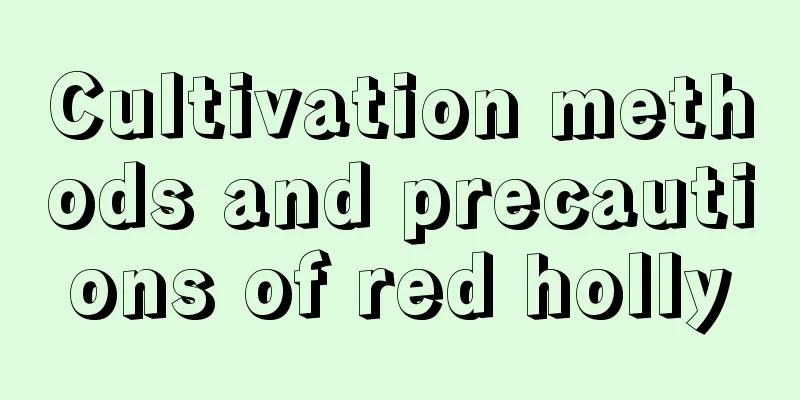Cultivation methods and precautions of red holly

1. Maintenance methods1. Temperature: Red holly likes warmth and its cold resistance is not good. Therefore, it can be maintained between fifteen and twenty-eight degrees. If planted in a place with very cold winters, certain cold-proof measures must be taken. 2. Light: Ilex redus is a light-loving plant. However, its shade tolerance is also good. In daily maintenance, it is better to provide sufficient light. Especially when the plant is growing fast, blooming, or bearing fruit, it should not be too dark. In winter, good light is also helpful for its wintering. 3. Watering: Red fruit holly likes moisture, but it is not tolerant to waterlogging. When watering, just water thoroughly and keep it moist during the growth stage, but don't let water accumulate. Some areas have more rain in the summer, so it is best to take some measures to drain away the excess rainwater. 4. Fertilization: Red fruit holly has good adaptability. Generally speaking, it does not need too much topdressing. It is better to apply it once every half a month or a month. Another thing to pay attention to is the basal fertilizer, which needs to be sufficient. 2. Breeding techniques1. Reproduction: Seeding propagation can be adopted. The fruits can be collected in autumn, and the seeds can be taken out after removing the peel. Then store it in moist sand. The best time to sow is in March of the following spring. Since it grows relatively slowly, it takes a long time for it to grow up. 2. Pruning: Red fruit holly has a very strong sprouting ability and is relatively resistant to pruning, so this step is more important. One is pinching in spring to promote more flowering after branching. Another thing is to prune some old and dry leaves during the dormant period. 3. Problem diagnosis and treatment1. Diseases: The diseases of red holly mainly harm the leaves, especially "leaf spot disease". It can be treated with carbendazim and the diseased leaves should be cut off in time. 2. Pests: The main pest is called "white wax scale", which is very harmful in itself and can also spread diseases. They are concentrated among the branches and leaves and need to be sprayed with pesticides in time for prevention and control. IV. Other issues1. Toxicity: It is non-toxic and has strong resistance to many toxic gases. 2. Can it be grown at home? Due to its very large size, it is generally not grown at home, but the fruit branches can be placed in a vase for viewing. |
<<: Cultivation methods and precautions of red clover
>>: Cultivation methods and precautions of red gentian
Recommend
How to cut leaves of the silkworm
1. Time Selection The right time is an important ...
How to save the rotten roots of tiger lily
1. Can root rot be saved? Whether the Sansevieria...
The advantages and disadvantages of Sakura Princess Rose
The petals of the Sakura Princess rose are white,...
How many years can Pansy be kept?
1. How many years can you raise it? Pansy is a pe...
Precautions for transplanting roses The best time and method for transplanting rose seedlings
Rose is a common plant that usually grows in a wa...
Can rosemary be propagated by cuttings? Which month has the highest survival rate of cuttings?
There are various ways to propagate rosemary, inc...
How to keep lilies alive
1. Plants grown in soil (1) Temperature: The plan...
What kind of environment does the red spider lily like? What kind of environment is the red spider lily suitable for growing?
1. Environmental requirements Red spider lily is ...
Cultivation methods and precautions of centipede grass water plants
The centipede grass is very easy to obtain and es...
Cultivation methods and precautions of asparagus fern
1. Temperature and environment The most suitable ...
How to make mountain roses bloom
1. Soil Mountain rose does not have particularly ...
How to breed cicadas?
Cicada is also called golden cicada , grasshopper...
The best time to water potted grapes
1. Before germination Before the plants sprout an...
How to grow lucky bamboo in water? What should I pay attention to?
Lucky bamboo is generally maintained by hydroponi...
Cultivation methods and precautions for potted aloe vera
1. Breeding methods 1. Soil: It is more suitable ...









